Boshen Xu
EgoDTM: Towards 3D-Aware Egocentric Video-Language Pretraining
Mar 19, 2025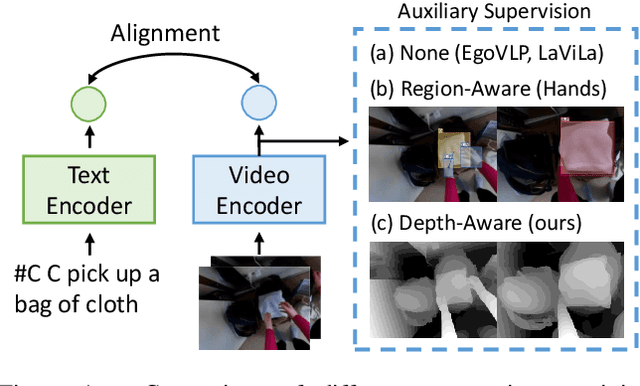

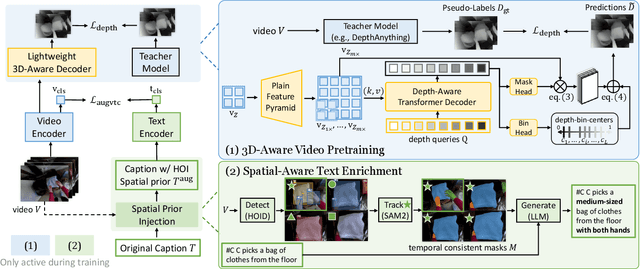

Abstract:Egocentric video-language pretraining has significantly advanced video representation learning. Humans perceive and interact with a fully 3D world, developing spatial awareness that extends beyond text-based understanding. However, most previous works learn from 1D text or 2D visual cues, such as bounding boxes, which inherently lack 3D understanding. To bridge this gap, we introduce EgoDTM, an Egocentric Depth- and Text-aware Model, jointly trained through large-scale 3D-aware video pretraining and video-text contrastive learning. EgoDTM incorporates a lightweight 3D-aware decoder to efficiently learn 3D-awareness from pseudo depth maps generated by depth estimation models. To further facilitate 3D-aware video pretraining, we enrich the original brief captions with hand-object visual cues by organically combining several foundation models. Extensive experiments demonstrate EgoDTM's superior performance across diverse downstream tasks, highlighting its superior 3D-aware visual understanding. Our code will be released at https://github.com/xuboshen/EgoDTM.
TimeZero: Temporal Video Grounding with Reasoning-Guided LVLM
Mar 17, 2025Abstract:We introduce TimeZero, a reasoning-guided LVLM designed for the temporal video grounding (TVG) task. This task requires precisely localizing relevant video segments within long videos based on a given language query. TimeZero tackles this challenge by extending the inference process, enabling the model to reason about video-language relationships solely through reinforcement learning. To evaluate the effectiveness of TimeZero, we conduct experiments on two benchmarks, where TimeZero achieves state-of-the-art performance on Charades-STA. Code is available at https://github.com/www-Ye/TimeZero.
EgoNCE++: Do Egocentric Video-Language Models Really Understand Hand-Object Interactions?
May 28, 2024Abstract:Egocentric video-language pretraining is a crucial paradigm to advance the learning of egocentric hand-object interactions (EgoHOI). Despite the great success on existing testbeds, these benchmarks focus more on closed-set visual concepts or limited scenarios. Due to the occurrence of diverse EgoHOIs in the real world, we propose an open-vocabulary benchmark named EgoHOIBench to reveal the diminished performance of current egocentric video-language models (EgoVLM) on fined-grained concepts, indicating that these models still lack a full spectrum of egocentric understanding. We attribute this performance gap to insufficient fine-grained supervision and strong bias towards understanding objects rather than temporal dynamics in current methods. To tackle these issues, we introduce a novel asymmetric contrastive objective for EgoHOI named EgoNCE++. For video-to-text loss, we enhance text supervision through the generation of negative captions by leveraging the in-context learning of large language models to perform HOI-related word substitution. For text-to-video loss, we propose an object-centric positive video sampling strategy that aggregates video representations by the same nouns. Our extensive experiments demonstrate that EgoNCE++ significantly boosts open-vocabulary HOI recognition, multi-instance retrieval, and action recognition tasks across various egocentric models, with improvements of up to +26.55%. Our code is available at https://github.com/xuboshen/EgoNCEpp.
SPAFormer: Sequential 3D Part Assembly with Transformers
Mar 09, 2024



Abstract:We introduce SPAFormer, an innovative model designed to overcome the combinatorial explosion challenge in the 3D Part Assembly (3D-PA) task. This task requires accurate prediction of each part's pose and shape in sequential steps, and as the number of parts increases, the possible assembly combinations increase exponentially, leading to a combinatorial explosion that severely hinders the efficacy of 3D-PA. SPAFormer addresses this problem by leveraging weak constraints from assembly sequences, effectively reducing the solution space's complexity. Since assembly part sequences convey construction rules similar to sentences being structured through words, our model explores both parallel and autoregressive generation. It further enhances assembly through knowledge enhancement strategies that utilize the attributes of parts and their sequence information, enabling it to capture the inherent assembly pattern and relationships among sequentially ordered parts. We also construct a more challenging benchmark named PartNet-Assembly covering 21 varied categories to more comprehensively validate the effectiveness of SPAFormer. Extensive experiments demonstrate the superior generalization capabilities of SPAFormer, particularly with multi-tasking and in scenarios requiring long-horizon assembly. Codes and model weights will be released at \url{https://github.com/xuboshen/SPAFormer}.
POV: Prompt-Oriented View-Agnostic Learning for Egocentric Hand-Object Interaction in the Multi-View World
Mar 09, 2024Abstract:We humans are good at translating third-person observations of hand-object interactions (HOI) into an egocentric view. However, current methods struggle to replicate this ability of view adaptation from third-person to first-person. Although some approaches attempt to learn view-agnostic representation from large-scale video datasets, they ignore the relationships among multiple third-person views. To this end, we propose a Prompt-Oriented View-agnostic learning (POV) framework in this paper, which enables this view adaptation with few egocentric videos. Specifically, We introduce interactive masking prompts at the frame level to capture fine-grained action information, and view-aware prompts at the token level to learn view-agnostic representation. To verify our method, we establish two benchmarks for transferring from multiple third-person views to the egocentric view. Our extensive experiments on these benchmarks demonstrate the efficiency and effectiveness of our POV framework and prompt tuning techniques in terms of view adaptation and view generalization. Our code is available at \url{https://github.com/xuboshen/pov_acmmm2023}.
* Accepted by ACM MM 2023. Project page: https://xuboshen.github.io/
Real-Time Video Super-Resolution on Smartphones with Deep Learning, Mobile AI 2021 Challenge: Report
May 17, 2021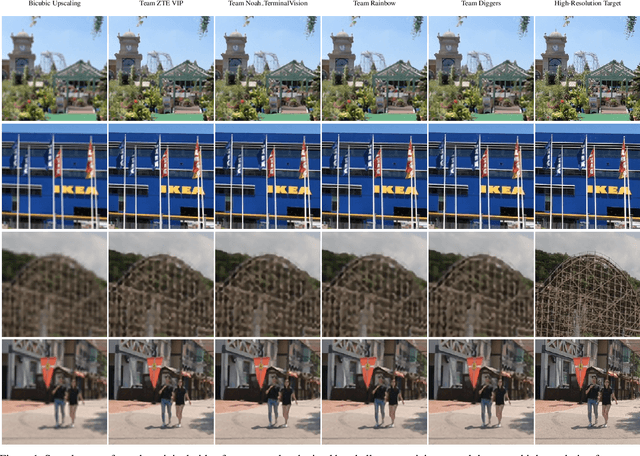

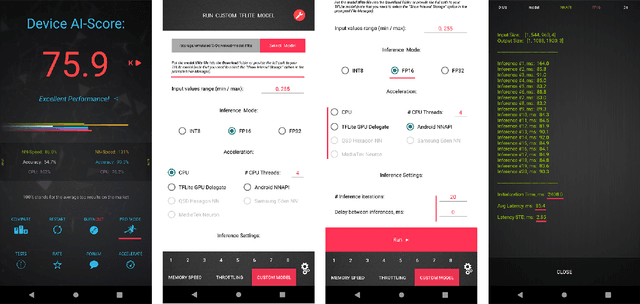
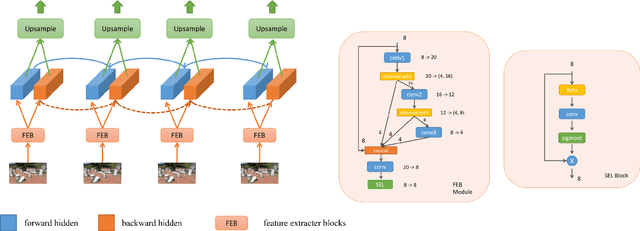
Abstract:Video super-resolution has recently become one of the most important mobile-related problems due to the rise of video communication and streaming services. While many solutions have been proposed for this task, the majority of them are too computationally expensive to run on portable devices with limited hardware resources. To address this problem, we introduce the first Mobile AI challenge, where the target is to develop an end-to-end deep learning-based video super-resolution solutions that can achieve a real-time performance on mobile GPUs. The participants were provided with the REDS dataset and trained their models to do an efficient 4X video upscaling. The runtime of all models was evaluated on the OPPO Find X2 smartphone with the Snapdragon 865 SoC capable of accelerating floating-point networks on its Adreno GPU. The proposed solutions are fully compatible with any mobile GPU and can upscale videos to HD resolution at up to 80 FPS while demonstrating high fidelity results. A detailed description of all models developed in the challenge is provided in this paper.
 Add to Chrome
Add to Chrome Add to Firefox
Add to Firefox Add to Edge
Add to Edge